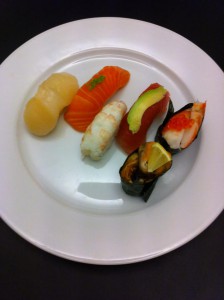In sushi restaurants in Tokyo there are approx. 15 different kinds of fish on the menu.
The Japanese people eat just as much fish in everyday life as we eat meat. When the Japanese visit a sushi restaurant in Tokyo, they want to taste as many different fish as possible.
The type of sushi that is most popular in Tokyo is nigiri sushi. Nigiri sushi is of a size that you as a guest can eat 10-15 pieces of sushi without feeling stuffed. Eating nigiri in Tokyo is an exciting experience. You get to taste many different fish that are not found in our latitudes.
In Europe we eat a little less fish. Most people eat fish 1-2 times a week. For one thing, sushi is one of the ways to get the recommended 350 gram of fish a week.
In Europe, sushi rolls are just as popular as nigiri sushi is in Japan. The selection is large, it is possible to taste several different rolls during a meal.
Read more about Sushi course for beginners
_
Zoë has lectured and held sushi courses for A. P. Moller – Maersk, Hugo Boss Nordic, Novo Nordisk, Novartis, Velux, Gorrissen Federspiel, Beierholm revision, Elbek & Vejrup and many more.








